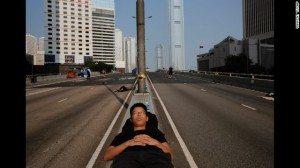By Doug Young, special to CNN
October 7, 2014 — Updated 0224 GMT (1024 HKT)
 A pro-democracy protester sleeps on a street in the occupied area surrounding the government complex in Hong Kong on Wednesday, October 8. Demonstrators are angry at China’s decision to allow only Beijing-vetted candidates to run in the city’s elections for chief executive in 2017. Demonstration crowds have begun to shrink as the protest
A pro-democracy protester sleeps on a street in the occupied area surrounding the government complex in Hong Kong on Wednesday, October 8. Demonstrators are angry at China’s decision to allow only Beijing-vetted candidates to run in the city’s elections for chief executive in 2017. Demonstration crowds have begun to shrink as the protest
progresses into its second week.
Editor’s note: Doug Young teaches financial journalism at Fudan University in Shanghai and is the author of The Party Line: How the Media Dictates Public Opinion in Modern China published by John Wiley & Sons. The opinions expressed here are solely his.
Shanghai (CNN) — Hong Kong’s pro-democracy demonstrations have been front-page fodder this past week in international media, which have painted the story as a David-and-Goliath struggle between local Hong Kongers and a powerful but distant authoritarian master in Beijing.
But no such headlines have appeared in China, where the story has been buried deep inside most newspapers and TV broadcasts, and is framed in a way that makes it uninteresting and unintelligible to average Chinese.
The coverage consists mostly of Beijing’s reactions to events with little or no explanation of what actually happened to prompt such response. The result is a hodgepodge of reports condemning the protests, saying that Hong Kong leader C.Y. Leung will never resign, and editorials declaring such protests will never spread to China.
It has also been noteworthy for the relative lack of images. From a media perspective, the demonstrations now taking place are a journalist’s dream come true, featuring colorful and action-filled images of protesters, police, politicians and conflict that make for great TV viewing and photos .
Yet none of those images have found their way into China’s official media, almost certainly on direct orders from propaganda officials who worry such pictures could inspire others in China to take similar action.
Strict bans on such inflammatory images are quite common in order-obsessed China, even when such protests are pro-Chinese. One such ban was a central feature in domestic coverage of a major territorial dispute with Japan two years ago, with major protests that broke out around China eerily absent from all domestic reports.
